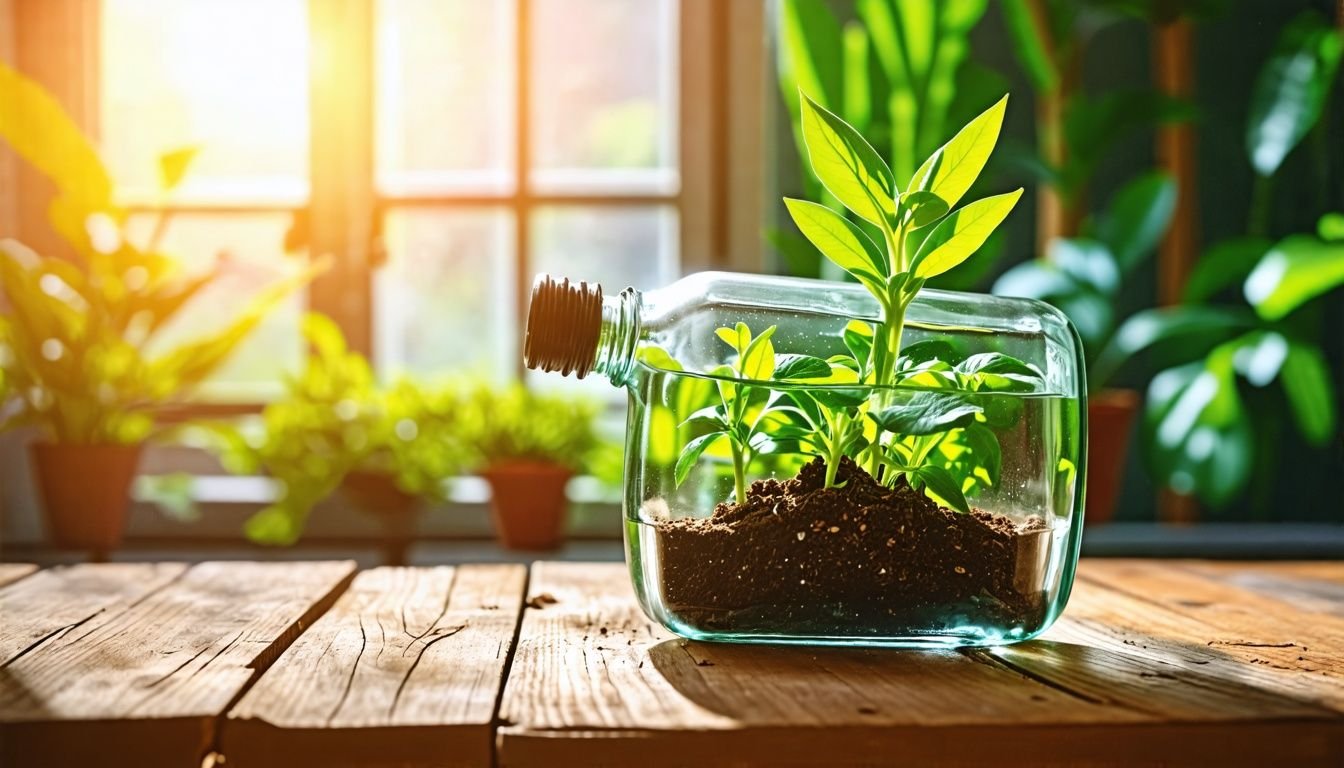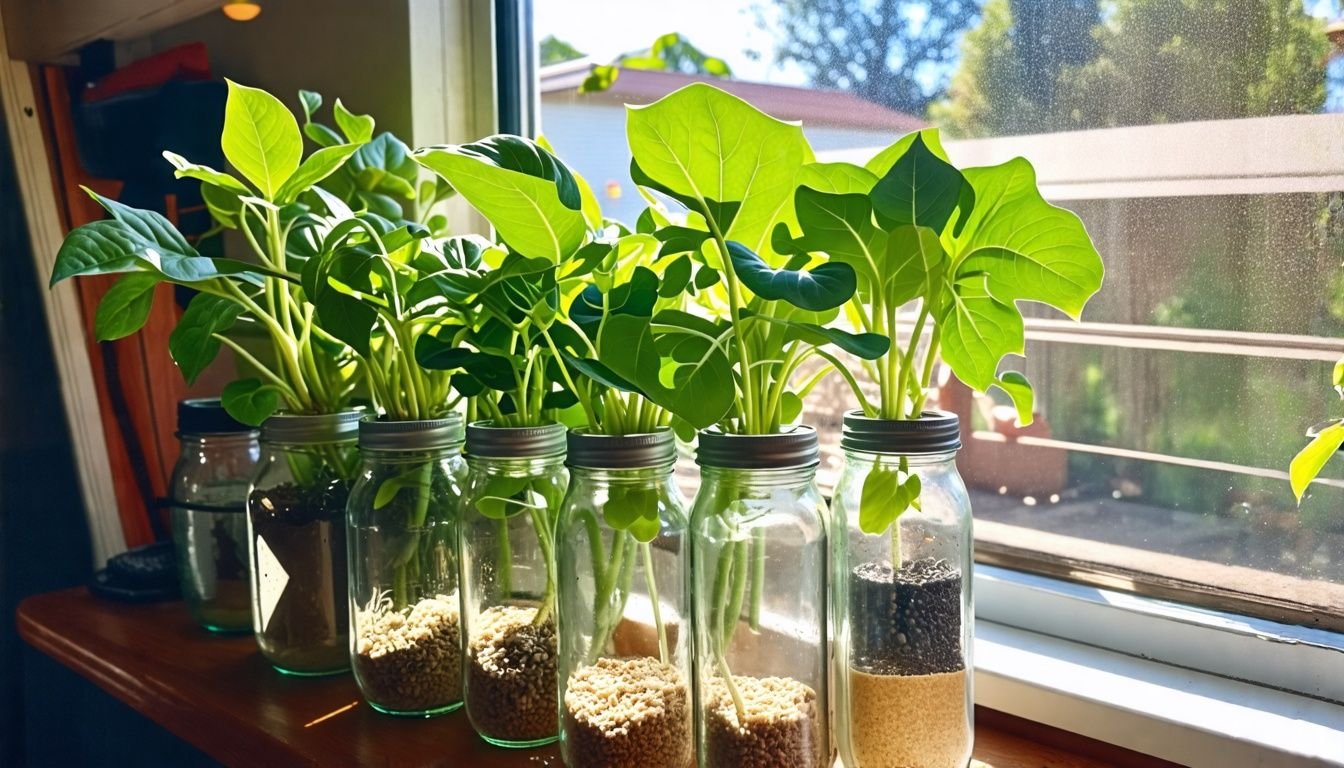G’day, plant lovers! Feeling a bit crook about coming home to wilted leaves and dry soil? No worries, we get it. Keeping our green mates happy and hydrated can be a real corker, especially for busy Aussies or those just starting out with their green thumbs.
We’ve all been there, cobber. Seen our fair share of sad-looking plants and felt proper guilty about it. That’s why we’ve done our research on DIY self-watering tricks. Did you know that Easyplant’s self-watering pots slowly feed water to the plant’s roots as needed? Bloody ripper, if you ask me!
In this guide, we’ll share our top tips and tricks for keeping your plants thriving with minimal effort. From glass bottle solutions to water wicking systems, we’ve got you sorted.
So, ready to give your plants a fair go and a good drink? Let’s get cracking!
Key Takeaways
- DIY self-watering methods like glass bottle solutions, houseplant baths, and water wicking systems can keep plants hydrated with minimal effort.
- The glass bottle method involves puncturing holes in a bottle cap, filling the bottle with water, and burying it in the pot to slowly release moisture.
- Houseplant baths involve soaking multiple pots in 5-10 cm of water for 30-60 minutes every 1-2 weeks, allowing plants to absorb water through drainage holes.
- Water wicking uses cotton ropes to draw water from a container into plant soil, providing a steady supply of moisture.
- Easyplant’s self-watering pots can help plants live up to 6 times longer than regular pots by slowly feeding water to the roots as needed.
Glass Bottle Solution

We love the glass bottle solution for its simplicity and effectiveness. This method uses common household items to create a self-watering system for your plants.
Step-by-step guide
The glass bottle solution is a simple yet effective DIY self-watering method for your plants. Here’s our step-by-step guide to set up this clever system:
- Gather materials: You’ll need a plastic water bottle, a nail, and a hammer. This project takes about 5 minutes.
- Prepare the bottle cap: Use the nail and hammer to puncture several small holes in the bottle cap.
- Clean the bottle: Rinse the plastic bottle thoroughly to remove any residue.
- Fill the bottle: Add fresh water to the bottle, leaving a small air gap at the top.
- Position in the pot: Dig a small hole in the potting mix, deep enough to submerge most of the bottle.
- Insert the bottle: Place the water-filled bottle into the hole, leaving 2-5 cm peeking out above the soil surface.
- Secure in place: Gently pack soil around the bottle to hold it upright.
- Cap it off: Screw on the punctured cap to control water flow.
- Monitor soil moisture: Check the bottle regularly and refill as needed to maintain consistent hydration.
- Adjust as necessary: If the soil becomes too wet or dry, experiment with the number and size of holes in the cap.
Houseplant Bath Technique
We’ve got a brilliant method for keeping your plants hydrated. Our houseplant bath technique is perfect for Aussie plant lovers looking for an easy way to water multiple plants at once.
- Fill your bathtub or sink with about 5-10 cm of water.
- Place a towel in the water to create a soft surface for your pots.
- Arrange your potted plants on the towel, ensuring they have good drainage holes.
- Let the plants soak for 30 minutes to an hour, allowing them to absorb water through the drainage holes.
- After soaking, move your plants to a spot with indirect sunlight to dry off.
- For smaller plants, use the saucer-soaking method instead. Fill the saucer with water and let the plant absorb it from below.
- Check your plants’ moisture levels regularly and repeat the bath every 1-2 weeks as needed.
- This technique works well for most houseplants, including ferns, peace lilies, and spider plants.
- Avoid using this method for succulents or cacti, as they prefer drier conditions.
- Clean your bathtub or sink thoroughly after each plant bath to prevent the spread of pests or diseases.
Water Wicking Drip System
Water wicking drip systems offer a clever solution for keeping plants hydrated. Let’s explore this easy and effective method for self-watering our green friends.
- Gather materials: We’ll need cotton rope, a vase or bucket, and our potted plants.
- Cut the cotton rope: Snip several pieces of rope, long enough to reach from the water source to the plant’s soil.
- Insert ropes into soil: Push one end of each rope into the plant’s soil, about 5-8 cm deep.
- Set up water container: Place a vase or bucket filled with water near the plants.
- Connect ropes to water: Dip the other ends of the ropes into the water container.
- Monitor water levels: Top up the container as needed to maintain a steady supply.
- Adjust as necessary: If soil gets too wet or dry, add or remove ropes to fine-tune the system.
- Clean regularly: Wash ropes and container every few weeks to prevent algae growth.
- Consider multiple plants: One large container can water several pots with this method.
- Enjoy low-maintenance care: Our plants stay hydrated while we’re busy or away.
Additional Resources for Plant Care and Maintenance
We’ve got more resources to help you become a plant care pro. Our team at Easyplant is ready to assist with any plant issues. Just drop us a line at hi@easyplant.com for personalised guidance.
We’re here to help your green friends thrive, no matter your skill level or lifestyle.
Social media is a great place to share your plant journey and learn from others. We love seeing your leafy companions flourish. Tag @easyplant in your plant photos on Instagram or Facebook.
It’s a fun way to connect with fellow plant lovers and show off your growing skills.
Our self-watering pots make plant care a breeze. They’re perfect for busy Aussies or those new to gardening. These clever pots keep your plants hydrated, helping them live up to six times longer than in regular pots.
They’re also brilliant gifts for friends and family who want to add a touch of nature to their homes.
Conclusion
Self-watering methods can make plant care a breeze. Our guide offers simple DIY solutions for busy Aussie gardeners. These techniques keep your green mates happy and healthy with minimal fuss.
Give them a go and watch your plants thrive. Your leafy friends will thank you for the constant hydration.
FAQs
1. What are self-watering planters?
Self-watering planters are pots that keep plants hydrated. They have a water reservoir. This system waters plants slowly over time.
2. Can I use self-watering planters in my bathroom?
Yes, you can use self-watering planters in your bathroom. They work well in humid spaces. These planters help maintain moisture for your bathroom plants.
3. How do self-watering planters work?
Self-watering planters have a bottom chamber for water. The soil wicks up water as needed. This keeps plants moist without overwatering.
4. Are self-watering planters good for all plants?
Not all plants suit self-watering planters. They’re best for plants that like consistent moisture. Succulents and cacti may not do well in these planters.
